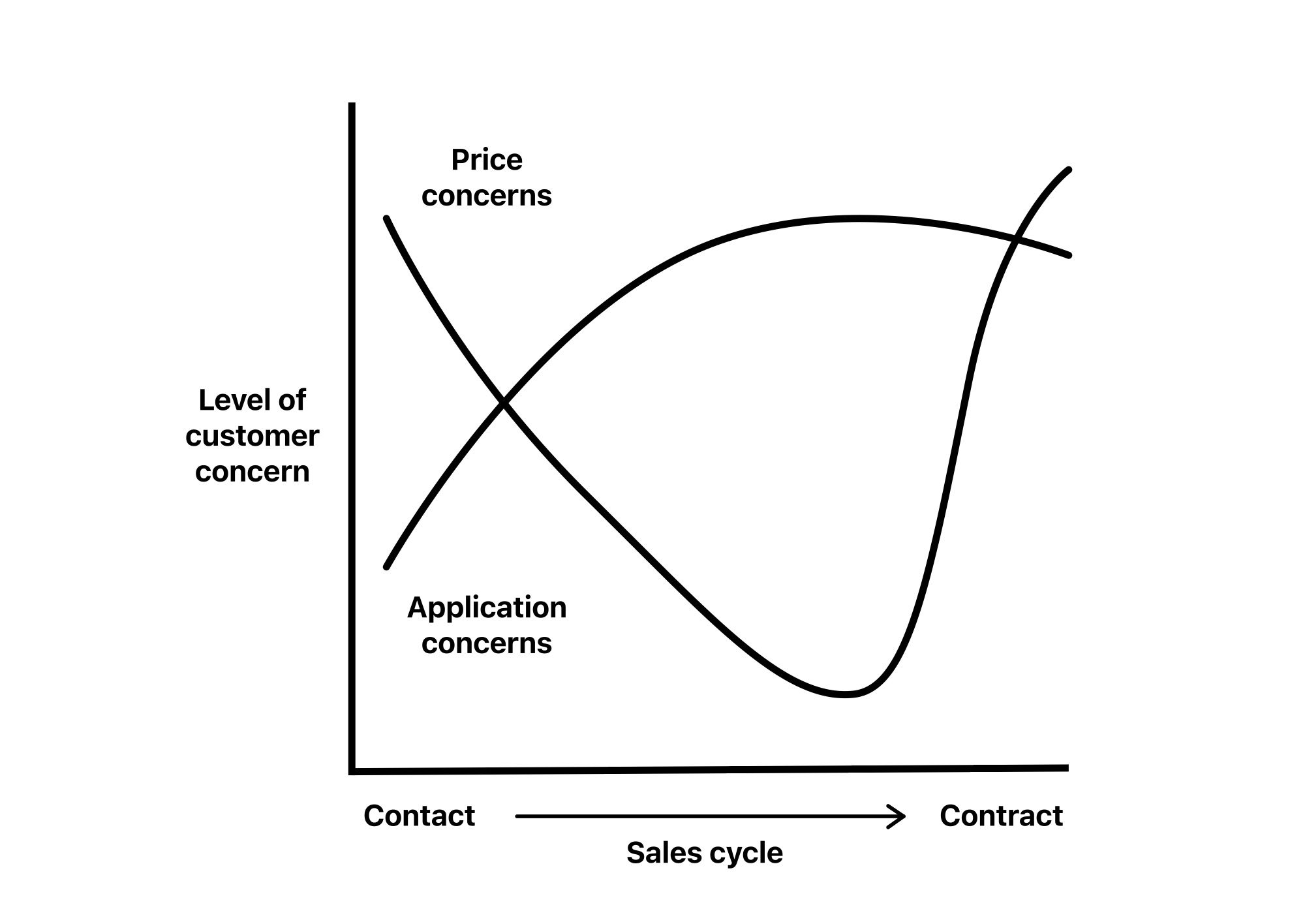There’s a common critical stage in many sales processes that demands your attention and it's about addressing your customer's concerns lingering under the surface. This is something for you to consider before stepping into negotiating and finalizing your complex deal. Overlooking what's discussed below may completely jeopardize your entire effort until this moment, so watch out!
Whereas in smaller transactions the risks are more contained, in strategic enterprise sales, the risks aren’t just higher – they multiply. We’re dealing with situations involving more stakeholders, increased competition, and prolonged decision-making timelines. Each of these elements can introduce unforeseen challenges.
Just as the complexity of your solution tends to increase, so do your client's apprehensions, worries and anxieties.
Insights from Neil Rackham’s book "Managing Major Sales" have been invaluable to me, especially regarding what he calls the "resolution of concerns" stage of a complex deal. This isn’t something that is encountered in every sale, but it’s something crucial for you to keep in mind when trying to conclude any sort of a larger agreement.
In my experience, buyers' fears vary greatly. Some might be straightforward, like concerns about timely delivery or worries with the installation. Others, however, are more sinister. They can be deep underlying trust issues in your ability to deliver, or they may have to do with buyer's own doubts of driving organizational acceptance for changes that are needed.
Such kinds of deeper psychological concerns having to do with human emotions, egos and perceptions are what Rackham refers to as "consequence issues", and they can be the silent deal-breakers if not recognized and addressed effectively.
Objectives of the pre-negotiation stage
- Determine whether consequence issues exist.
- Clarify and understand these issues.
- Aid the client in navigating and resolving these concerns. It’s important to remember that resolution of these issues lie with the client, not with you as the seller.
Understanding the roots of consequence issues
Consequence issues are essentially the risks or downsides that a client perceives possibly resulting from deciding in your favor. Often, these are disguised as concerns about pricing, which are the more acceptable way to express deeper underlying issues to the seller. Noticeably, price concerns tend to fluctuate, dipping in the middle of the sales cycle and peaking again later when discussions pivot towards finalizing the deal.

The pattern in price concern visible in the illustration above can be attributed to a shift in focus during the deal cycle – from initially understanding the benefits of a solution to then starting weighing the costs versus benefits and finally to negotiating and concluding the agreement. The cost side of the buyer's equation may not encompass just the price tag itself but any amount of other potential risks such as implementation challenges, internal politics or other hassles.
Research done by Rackham indicates that in many instances, price concerns are a facade for other, more intricate issues. It’s simpler for clients to attribute their hesitation to cost rather than to delve into more nuanced issues like trust problems or other potential risks. As such, price often serves as a convenient smokescreen for other possible deeper underlying concerns.
Identifying consequence issues
Spotting these sorts of consequence issues demands sensitivity and a keen eye for noticing their typical manifestations and recognizing characteristics of situations where they tend to arise. Here are some factors that are conductive for consequence issues to start lingering under the hood without manifesting themselves openly to the seller:
- Scale of decision: Is the decision significant for the buyer?
- Visibility and pressure: Is there pressure related to decision's visibility in your customer's organization? Would the impact resulting from your product or solution's be felt across your customer's entire enterprise?
- Competitive landscape: Are there established or existing competitors present or trying to enter into the account?
- Technological unfamiliarity: Does your product or service represent a significant departure from familiar technology? This can heighten your client's risk perception.
Some concrete indicators of existing consequence issues may include the constant resurfacing of old issues that you thought you had already addressed and resolved with your client. The price concerns may be completely disproportionate, or unexplained delays or sudden changes in your accessibility to previously available decision-makers may come up. Any of these signs can point to underlying concerns lingering beneath the surface that the client is hesitant to voice.
Handling consequence issues
Recognizing consequence issues is the initial step. Effectively addressing them requires a nuanced, empathetic approach. In short, here is what you must consider in your deals:
- Recognize and acknowledge their existence: Ignoring these issues doesn't make them vanish. Being aware of their potential impact is crucial.
- Build trust and cultivate relationships early: Establishing a foundation of trust early in the sales cycle is key for a more open dialogue later down the road.
- Help the client resolve their issues: The resolution of consequence issues is ultimately up to the client and their journey. Your role is to facilitate a conducive environment for their resolution. Don't make the mistake of trying to overcome them forcefully.
Rackham cautions against three critical mistakes sellers tend to make when trying to manage consequence issues – (1) minimizing, (2) prescribing, and (3) pressuring. This only aggravates the problems instead of aiding in their resolution.
Actions to avoid and the "deadly sins"
Navigating consequence issues is akin to a tightrope walk – it requires a delicate balance. While it’s crucial to recognize and address these issues, how you approach them can significantly impact the outcome. In my experience, and as aptly stated by Rackham, there are certain pitfalls that we, as sales professionals, must consciously avoid to ensure we don't inadvertently compound these issues:
- Minimizing client's concerns: One of the most common missteps is to belittle or downplay your buyer's concerns. It’s easy to fall into the trap of reassuring them with a simple “Don’t worry about it,” or “It’s not a big deal.” However, this approach can backfire. It might come off as dismissive, suggesting that you are not fully acknowledging the weight of their concerns. This can drive the real issues underground, allowing significant concerns to remain hidden and unresolved. It’s essential to validate the client's worries, showing that you understand and take them seriously.
- Prescribing solutions: Another pitfall is jumping too quickly to offer solutions. In the eagerness to resolve the issue, you might start providing recommendations or dictating how the client should address their concerns. However, consequence issues are not your typical straightforward problems; they are often complex, involving layers of emotions and perceptions. Offering solutions too early, especially before fully understanding the problem, can lead to increased resistance from the client. It’s more about guiding them to find their own solutions rather than dictating your own. This is not so different from how psychologists or counselors tend to help their clients with various types of complex emotional problems and perceptive issues they may have.
- Exerting Pressure: In sales, there’s always a temptation to push a little to close the deal, especially when we’re so close to the finish line. However, applying pressure in situations where deeper consequence issues are at play can be counterproductive. It can heighten the client's stress and amplify their concerns, making them even more hesitant to commit. The key is to give them space and time to process and decide. High-pressure tactics, which might work in simpler sales scenarios, can often backfire in complex, high-stakes situations.
In handling consequence issues, it’s paramount to tread carefully. Depending on the type of sale and situation at hand, before starting negotiations, our role could be thought of as being facilitators – someone who listens, understands, and helps the client navigate through their concerns, rather than pushing the sale with force.
Your focus should remain on building trust, creating a safe space for open discussion, and guiding our clients towards finding their own resolution to any of their possible deeper emotional, perceptive or organizational issues and concerns. It’s a subtle art, requiring patience and empathy, but mastering this can significantly enhance our effectiveness as sales professionals acting in a complex environment.
Concluding thoughts
During late stages of the sales cycle, understanding and managing consequence issues is essential. This article has highlighted the tell-tale signs of such issues, the intricacies of addressing them, and the importance of fostering trust and relationships early on in the sales process. It’s crucial to remember that resolving these issues lies with the client. What we can do as sellers is to identify these concerns and bring them out of obscurity and on the table to be dealt with more effectively. Avoiding the trap of minimizing, prescribing, and pressuring is key to navigate these complex scenarios with professionalism and tact, resulting in better deals and more impact.
If you enjoyed this post, remember to subscribe below. You'll get an occasional hand-made email right into your inbox. I'll do my best to make it interesting and I won't waste your time. You'll be able to unsubscribe at any time. Talk to you soon!

